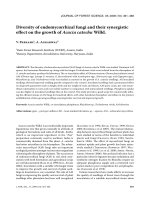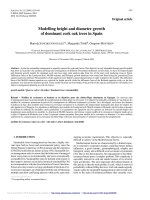Optical submarine cables and their security the growth of russian and chinese threats in the atlantic basin and beyo
Bạn đang xem bản rút gọn của tài liệu. Xem và tải ngay bản đầy đủ của tài liệu tại đây (34.31 MB, 132 trang )
on the background
classical geopolitics: a global Atlantic-centric
take
as seen in Google Earth,
image, NASA, overlooking the North Atlantic
image, NASA, centered on the wide South Atlantic
A Room with a View
“classical” global geopolitics: the opening fo the Atlantic as a Mare
Nostrum, and then a Mare Clausum: the Tordesillas Treaty and the
Portuguese commercial routes during the XVIth Century (in blue) and
the “española” ones (these latter ‘de longo curso’ and in white, here)
revisiting horror: from the first to the early stages of
the second wave of globalization: a view of the slavetrade, Africa-Americas, 1650-1860
the South Atlantic and the first
globalization: ports (harbours) in Atlantic
Basin and the Portuguese and ‘Spanish’
routes, 15th to 18th centuries
a peak at the current reawakening of the South Atlantic, after the
Panama enlargement, after the eventual TTIP, if Trump allows it: the
new (but surely not the largest) Basin harbours - those being built,
enlarged or in fieri – shall mostly be located on the south of the Basin.
So will likely be active militarization and underlying social movements
The reawakening of the South Atlantic after a period of dormancy.
Napoleon fate (beyond the horizon”, after Elba’s failure and Waterloo
a reawakening: after a light WWI U-boat war, a
heavier one in WW2: the nazi sub U-848, “under
north-american attack”, in the northern reaches of
the South Atlantic, 5th of November, 1943
a harsh wakeup call: “places (and numbers) where Brazilian ships were sunk
during World War II, after Brazil joined the Allies. The grand total of sunk Allied
ships was 389, for the 1941-1943 interval”. ## ships sunk by the axis per week
the backlash: known Nazi U-boats sunk , 1941-1943; a few were blown
to bits by the Forỗa Expedicionỏria Brasileira but most were taken
care of by theAmerican Air Force, ewho then was asked by the
Brazilian Govt.. To create a majoprAir Force Base in Natal
President Theodore Roosevelt at the Canal de
Panama, visiting the chantier, 1908
the almost finished Panama Canal, 1913
left, USS Missouri, crossing the Panama Canal, 1945, back from Japan to
the USA; right, the old and new routes of the Great White Fleet of
President Teddy Roosevelt, and the shortcut needed after the ‘Conquest
of the West’
A fast-forward, and a look at technological evolution:
Panama Canal enlargement works, by 2012
In 2014, Mau Tempo no Canal? The enlargement was
consumated on 6 June 6th, 2016, doubling its width, thus
quadrupling its volume
the works: “enlargement works and a
passing luxury cruise ship”, March 2013
the whys and the hows. Waiting queue, Canal de Panama (2013) on
the Pacific side, and the alternatives for the ‘unbottling’: that of the
“Canal Seco” via Costa Rica (2012) and that of the “Canal de
Nicaragua” (2014) via the latter one; but both with China
la abertura del Canal de Panama alargado: Monday, June
6th, 2016, at 5:07 pm. a Chinese ship blazing the new trail.
again, a view form above: Panama Canal and PortMiami
Renew MOU, as the port welcomes its first NeoPanamax
vessel (of course, a Chinese vessel): look at how it fits...
reading things: global density of commercial
exchanges, 2016-2017.
The colours: in yellow, the more populated regions, in
reddish, the less populated ones
map of the regions with more intense emissions of carbon
dioxide, CO2, coded in colours. In green, the “greener” zones,
which hue from yellow to red as it gets worse (2016).
another background look: ‘coordinated migrations’ and
urbanization, before the onset of the ‘Syrian crisis’: map of
coordinated migration, and, in yellow shade, countries with
biggest urbanization growth, 2002-2019









